Discover the Delight of Kway Teow Cooking
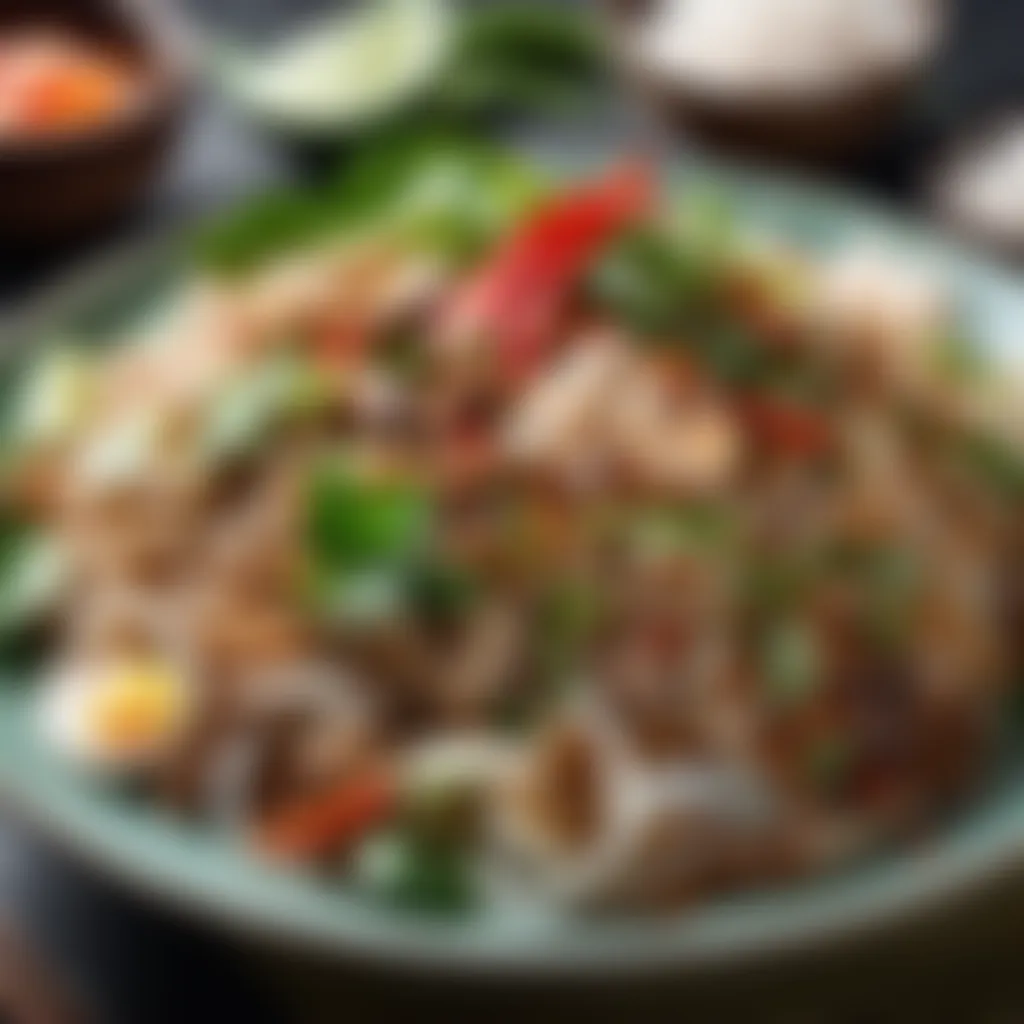

Intro
Kway Teow is not just a simple noodle dish; it's a reflection of cultural richness and history that spans across various regions in Asia. Whether you’re enjoying it in a bustling hawker center in Malaysia or a quiet noodle shop in Thailand, the essence of this dish resonates with people’s palates and stories. This article will guide you through the journey of creating this delightful dish, from gathering the ingredients to savoring the finished plate. In doing so, it allows both seasoned cooks and novices to understand and appreciate the art of Kway Teow.
Ingredients:
Here’s a detailed list of what you'll need to create a satisfying plate of Kway Teow:
- Kway Teow Noodles: 400 grams (these flat rice noodles are essential)
- Chicken Breast or Shrimp: 250 grams (sliced thinly, if using chicken)
- Eggs: 2 large (whisked)
- Garlic: 3 cloves (finely minced)
- Chives: 50 grams (chopped)
- Bean Sprouts: 100 grams
- Soy Sauce: 3 tablespoons (dark soy sauce serves well)
- Oyster Sauce: 2 tablespoons (for depth of flavor)
- Sesame Oil: 1 tablespoon (for a nutty aroma)
- Vegetable Oil: 3 tablespoons (for stir-frying)
- White Pepper: 1 teaspoon (for seasoning)
- Salt: as needed (to taste)
Preparation Steps:
Now that we have our ingredients ready, let’s walk through the preparation steps:
- Soak the Kway Teow Noodles: If using dried noodles, soak them in hot water for about 10-15 minutes until they soften. Drain and set aside.
- Prepare the Ingredients: Slice the chicken or shrimp, mince the garlic, chop the chives, and rinse the bean sprouts. Having everything ready will make cooking smoother.
- Whisk the Eggs: In a bowl, whisk the eggs until you see a uniform mixture, set aside this mixture for later.
Technical Aspects:
Here, we’ll focus on some critical guidelines to follow:
- Temperature Settings: The heat should be set to medium-high during the cooking process to ensure quick stir-frying without burning.
- Timing Specifics: Each stir-frying step should not exceed 2-3 minutes to prevent overcooking the ingredients.
- Critical Techniques: The important technique used in this recipe is ‘wok hei,’ the breath of the wok. It refers to the smoky flavor achieved when ingredients are cooked over high heat in a well-seasoned wok.
Cooking Process:
- Heat the Wok: Begin by heating your wok. Once it's hot, add the vegetable oil. Swirl the oil around to coat the sides.
- Sauté Garlic: Add the minced garlic to the hot oil, stirring it quickly until fragrant, around 30 seconds. Be careful not to let it burn.
- Cook Chicken or Shrimp: Introduce the sliced chicken or shrimp and stir-fry for about 2 minutes, until cooked through.
- Incorporate Noodles: Add the soaked Kway Teow noodles to the wok, mixing everything well.
- Add Sauces: Pour in the soy sauce, oyster sauce, and sprinkle the white pepper. Toss everything together until the noodles are well-coated in the sauce and heated through.
- Add Eggs and Chives: Create a well in the center of the noodles, pour in the beaten eggs, and let it sit for a minute. Scramble the eggs gently and mix into the noodles, then add the chives and bean sprouts.
- Final Touches: Stir everything together for about 1-2 more minutes and taste. You can add more salt if necessary.
Troubleshooting Tips:
- Noodles are Too Sticky: If you find your noodles sticking together, they might have not soaked long enough. Ensure they’re well-drained after soaking.
- Flavor is Lacking: If the flavor seems flat, a splash of extra soy sauce or a dash of salt can lift it.
- Overcooked Ingredients: Keep a close eye on the cooking time; overcooked chicken transforms into rubbery bites.
"Cooking Kway Teow is as much about technique as it is about comfort. Embrace the process, keep it simple, and allow the flavors to unfold naturally."
Ending
Now that you�’ve navigated through the preparation and cooking steps of Kway Teow, you have not just a recipe but a chance to connect with a culinary tradition. Invite family and friends to enjoy the fruits of your labor, while you share the stories hidden in every bite.
Understanding Kway Teow
In the realm of Asian cuisine, Kway Teow holds a special place that transcends mere sustenance. This dish not only represents a collection of flavors and textures but also signifies deep cultural roots and time-honored traditions. For anyone looking to truly appreciate Kway Teow, understanding its components and historical context is essential.
The richness of Kway Teow comes from its simplicity and versatility. To the untrained eye, it might appear to be just another noodle dish, but dive a bit deeper, and one discovers a world of culinary artistry. The smooth rice noodles carry flavors that transport one from bustling street markets in Malaysia to fine dining restaurants. Grasping the fundamentals of Kway Teow lays the groundwork for crafting an exquisite dish that is both comforting and recreates the essence of its origins.
Origins of Kway Teow
The journey of Kway Teow began in Southern China, specifically in the region of Guangdong, where it was a staple for many. The name itself conveys a relationship with rice, as Kway Teow translates to ‘rice noodle’ in Cantonese. Brought forth by Chinese immigrants, this dish has transformed, adapting itself to the local cultures, particularly throughout Malaysia and Singapore.
Historically, Kway Teow was humble fare, enjoyed primarily by the working class. It gradually gained prominence as street hawkers recognized its popularity, leading to a myriad of preparations concentrated on bold, distinct flavors. Different regions added their own twist—some added rich soy sauces while others leaned on fresh ingredients unique to their locale.
Cultural Significance
Kway Teow serves as more than just a meal; it’s a piece of identity. In many Asian cultures, food is a language of love, history, and hospitality. Preparing Kway Teow connects generations, binding family and friends as they share recipes and techniques passed down through years.
This dish appears frequently at significant cultural festivals, celebrating moments like Chinese New Year where it symbolizes prosperity and reunion. The act of cooking and eating Kway Teow reflects a way of honoring one’s roots while fostering a sense of belonging.
In summary, understanding Kway Teow means appreciating a dish steeped in rich history and culture, elevating it beyond the plate while enhancing the dining experience itself.
Key Ingredients
Understanding the key ingredients of Kway Teow not only enriches your culinary experience but also honors this traditional dish's heritage. Each component plays a significant role in crafting the intense flavors that enthusiasts rave about. Whether you’re a seasoned cook or someone still navigating the waters of the kitchen, having a firm grasp on what goes into this dish is crucial.
Main Components
The main components of Kway Teow include flat rice noodles, proteins, and vegetables. The base of the dish, the Kway Teow noodles, are wide and smooth, designed to soak up sauces and flavors beautifully.
- Rice Noodles: The soul of Kway Teow, these noodles offer a slight chewiness. You can typically find them in wet or dry forms. Wet noodles boast a fresh texture, while dry ones can hold sauces exceptionally well.
- Proteins: Depending on your preference, proteins such as chicken, shrimp, or even beef can elevate the dish. Each protein brings its unique flavor, seamlessly blending with the dish's sauce.
- Vegetables: Common choices like bean sprouts and chives add fresh crunch and brightness. This blend of ingredients not only creates a symphony of textures but also enhances the visual appeal of your meal.
Essential Condiments
Condiments are what take your Kway Teow from simple to sensational. They add layers of complexity and play off the dish's inherent flavors. Some indispensable condiments include:
- Soy Sauce: A fundamental ingredient that weaves through the dish, contributing both umami and color. The balance of dark and light soy provides depth.
- Chili Paste: For those who enjoy a kick, chili paste is ideal. A small dollop can amplify the dish without overpowering it.
- Sugar: It may sound odd, but a pinch of sugar does wonders in rounding off the flavors, balancing the savory notes.
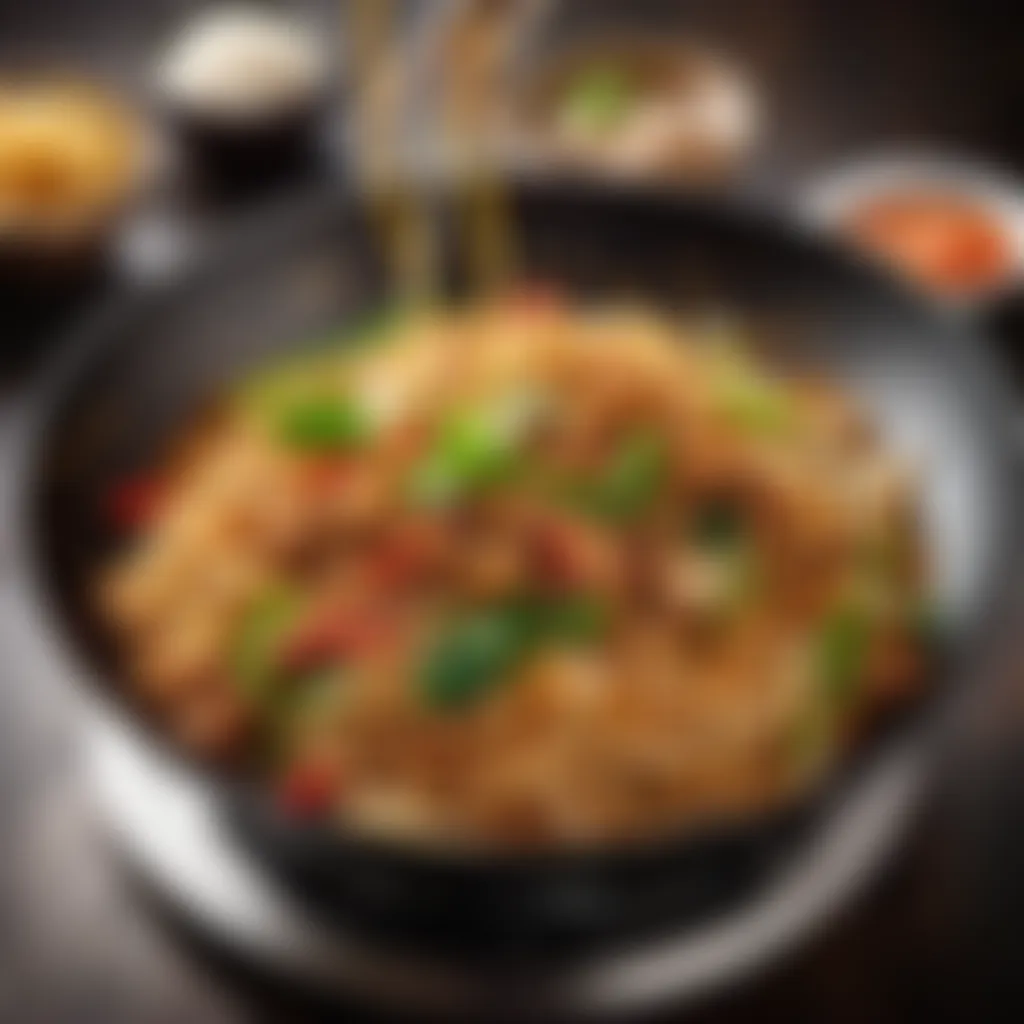
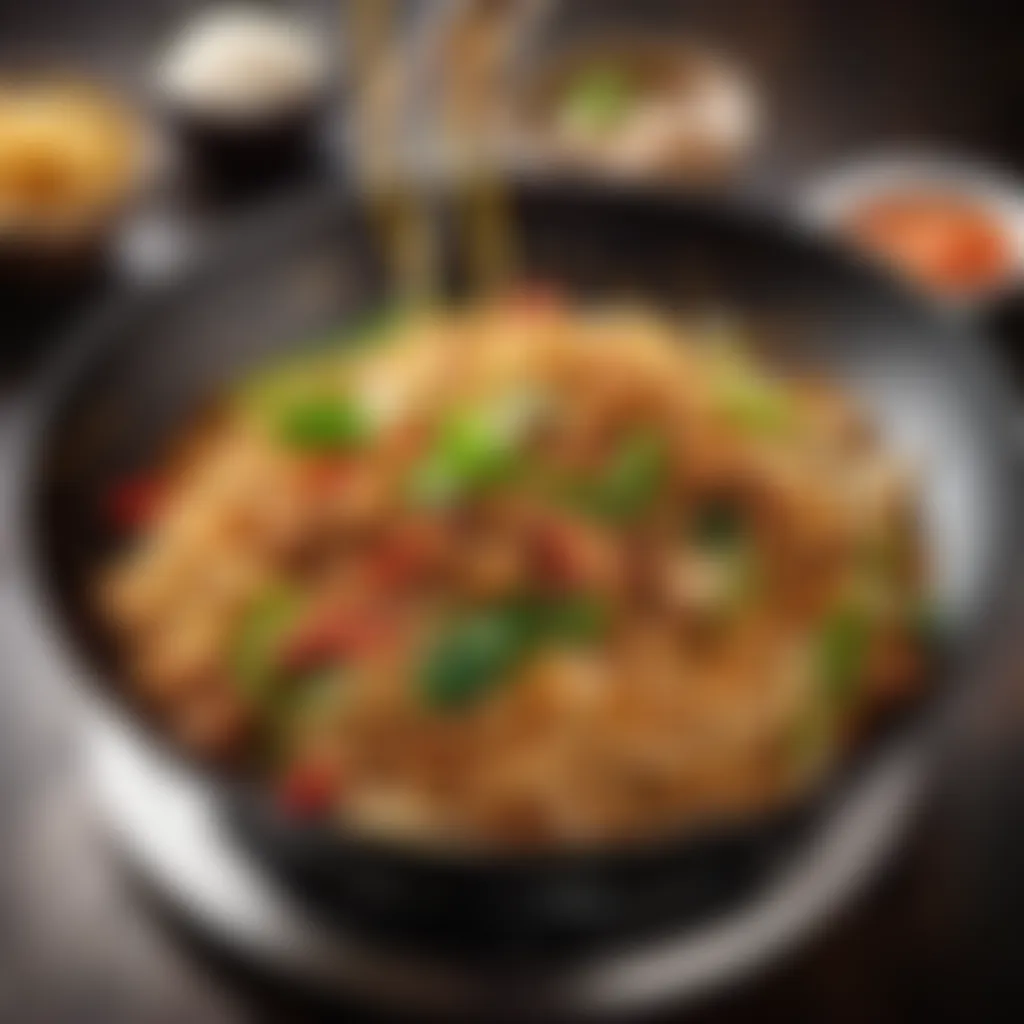
Always taste as you go, adjusting the seasonings to get it just right.
Choosing Quality Noodles
Selecting the right noodles is paramount in ensuring your Kway Teow stands out. Opt for fresh noodles whenever possible, as they provide a better texture and taste. Here are some considerations:
- Look for Texture: Good quality noodles should be somewhat elastic and slightly translucent. Avoid any that feel overly dry or too soft.
- Check the Ingredients: A straight list of rice flour and water is ideal. Some commercial brands may add preservatives that can affect the taste.
- Local Markets: Often, fresh noodles can be found at local Asian markets. Purchasing them from a vendor with a good reputation usually leads to a better culinary experience.
By focusing on these essentials, not only do you prepare a dish that resonates with tradition, but you also create a meal that draws people together. As they say, good food is about good company, and Kway Teow is a great way to start that connection.
Preparation Techniques
Preparation techniques play a crucial role when it comes to crafting a delicious plate of Kway Teow. They ensure that the flavors meld beautifully and that the ingredients retain their distinctive qualities. By mastering these techniques, cooks can create dishes that not only taste delightful but also carry depth and complexity. Each step in the process builds on the last, harmonizing textures and flavors to achieve the ultimate dish.
Marinating Proteins
Marinating proteins is one of the foundational steps in preparing Kway Teow. This process involves soaking some type of meat or seafood in a mixture of seasonings, which can include soy sauce, sesame oil, garlic, and other flavor enhancers. To get the most out of the marinade, let the proteins soak for at least 30 minutes. This not only infuses the proteins with flavor but also tenderizes them, paving the way for a sumptuous bite.
When marinating, the general rule of thumb is to keep it simple. Over-seasoning can overpower the dish. For instance, marinating strips of beef or chicken with just a little soy sauce and a splash of rice wine vinegar allows the natural flavors to shine through while adding a savory kick. Make sure to reserve a small portion of the marinade to drench the noodles later, enhancing the flavor even more.
Sautéing: The Heart of the Dish
Sautéing is where the magic happens. It’s an essential technique for cooking Kway Teow and involves cooking ingredients quickly over high heat. This method brings out flavors, enhances textures, and combines all components into a cohesive dish. To sauté effectively, use a well-seasoned wok—this kind of cookware is ideal as it heats evenly and maintains high temperatures necessary for quick cooking.
The process demands a keen sense of timing. Toss in your marinated protein first, allowing it to sear and release its juices. Once the proteins are nearly cooked through, you can add vegetables such as bean sprouts, bok choy, or green onions. After that, the noodles come into play. Ensuring that everything is tossed well ensures that each piece is coated in the savory flavors of the dish. This moment is crucial; a careful sauté can make or break the taste experience.
Managing Cooking Times
Cooking time might seem minor, but it’s critical in achieving the desired texture of Kway Teow. Overcooked noodles become mushy, not giving that signature bite that is so beloved in this dish. The goal is to reach a perfect al dente finish—a term borrowed from Italian cooking, meaning to the bite.
To manage cooking times effectively, consider having all your ingredients prepped beforehand. This includes having the vegetables chopped, proteins marinated, and noodles ready to go. A good cook can time all components so they finish simultaneously. For instance, while the proteins are cooking, briefly soak the noodles in hot water to soften just before they hit the wok. This reduces overall cooking time, allowing you to bring all the elements together swiftly. Keeping a close eye on each component ensures that the whole dish is a unified, delicious triumph.
Cooking is not just about following recipes; it’s about understanding how each step interacts with the next.
Flavor Profiles
The flavor profiles of Kway Teow are like a finely tuned orchestra, where each ingredient plays its role in creating a satisfying melody on the palate. This section highlights how to harmonize different flavors, emphasizing the balance between sweet and savory, the use of aromatics, and the subtle hints of spice that can elevate this dish from simple to extraordinary.
Balancing Sweet and Savory
Achieving the right balance of sweet and savory is crucial in Kway Teow, and it often begins with the choice of sauces. Soy sauce, for instance, brings an umami depth that contributes to the savory side. Adding a touch of oyster sauce can enhance the richness while giving a slight sweetness. Meanwhile, a moment of sweetness can be introduced by using a bit of sugar or even sweet soy sauce. Think of it as a dance; you want the flavors to complement rather than overshadow each other.
Tip: Aspiring cooks should consider a taste test midway through cooking. A few drops of soy sauce or a sprinkle of sugar can be adjusted according to personal preference. It’s all about finding that sweet spot of flavor harmony.
Utilizing Aromatics
Aromatics are the unsung heroes of flavor in many dishes, and Kway Teow is no exception. Garlic and shallots are often used as a base, their fragrances wafting through the kitchen like an invitation for dinner. When sautéed, these ingredients become golden, releasing essential oils that add complexity to the dish. Don’t forget about fresh herbs like cilantro, or even green onions, as they impart a vibrant freshness that counters the heaviness of the noodles.
Common Aromatics Used:
- Garlic
- Shallots
- Cilantro
- Green Onions
- Chili Peppers
These ingredients should be included early in the cooking process to allow their flavors to emerge fully. The combination of these aromatic elements creates a rich flavor landscape that is both inviting and intriguing.
Hints of Spice
Spices in Kway Teow are where the magic often happens. Though it shouldn’t steal the show, a hint of spice adds dimension. Start with white pepper for a gentle warmth or chili flakes for a bit of kick. About a teaspoon while cooking should suffice, but the level of heat can be adjusted according to your flavor tolerance. Adding spice gives the dish a lively character, making each bite an experience to remember.
Incorporating spice isn’t just for the heat; it also elevates the overall flavor profile, turning what could be an ordinary noodle dish into something truly special.
The End
When it comes to Kway Teow, mastering the flavor profiles is essential. By balancing sweet and savory, utilizing aromatics effectively, and incorporating just the right amount of spice, you're well on your way to creating a delightful dish that resonates with both tradition and personal preference. Pay attention to how flavors interact, and let your taste preferences guide you. Every cook has their secret, and these flavor elements can be adjusted to craft your own signature version of this beloved dish.
Variations of Kway Teow
Kway Teow, cherished for its delightful texture and flavor, is more than just a noodle dish. It's emblematic of diverse culinary traditions across Asia, with each region leaving its own unique stamp on the recipe. Exploring the variations of Kway Teow not only broadens one's culinary horizon but also serves as a window into local history and culture. Whether you’re preparing a hearty meal for your family or experimenting for a special occasion, understanding these variations can enhance your cooking experience and elevate your dish.
Regional Interpretations
The beauty of Kway Teow lies in its adaptability, which allows it to take on local flavors and styles. For instance, in Malaysia, the dish often features a robust and aromatic blend of spices, showcasing a medley of flavors. Penang’s Char Kway Teow is famous for its dark soy sauce and crispy pork lard, making it a local favorite.
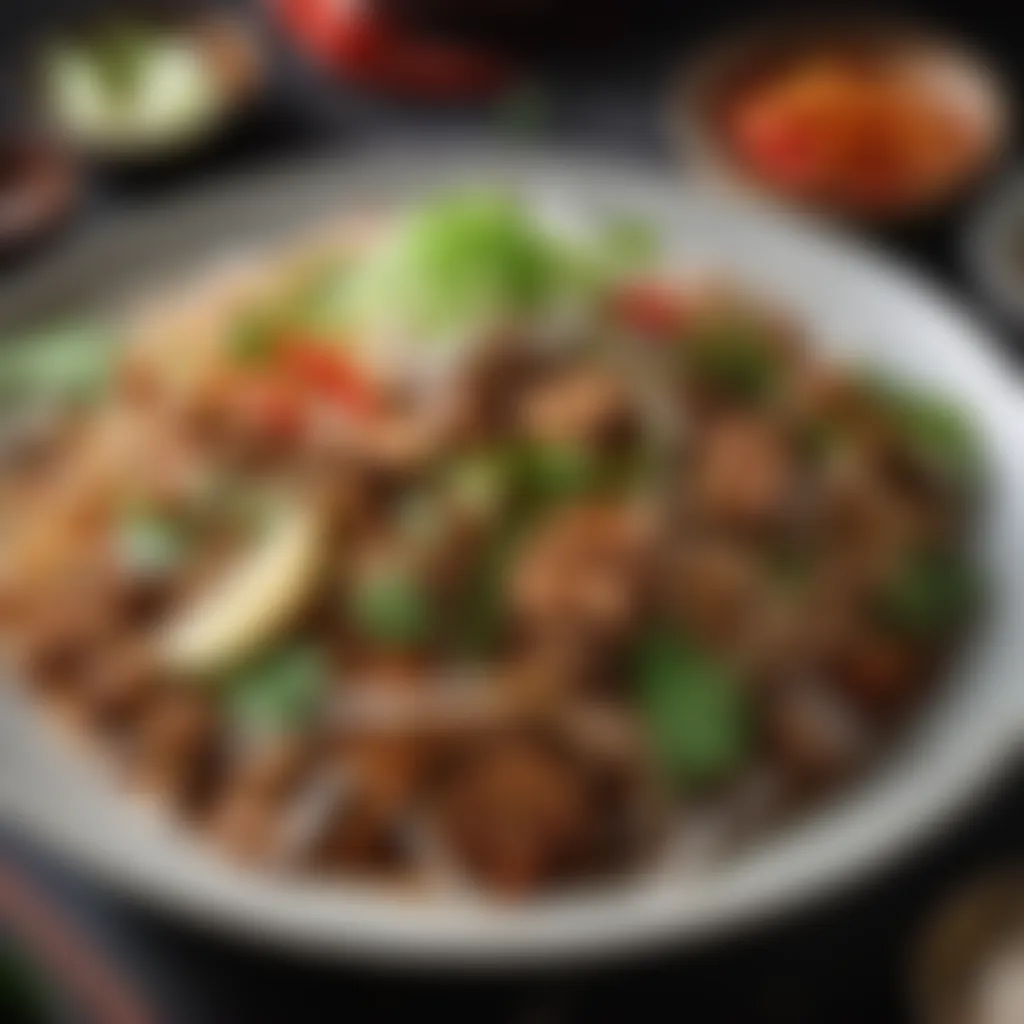
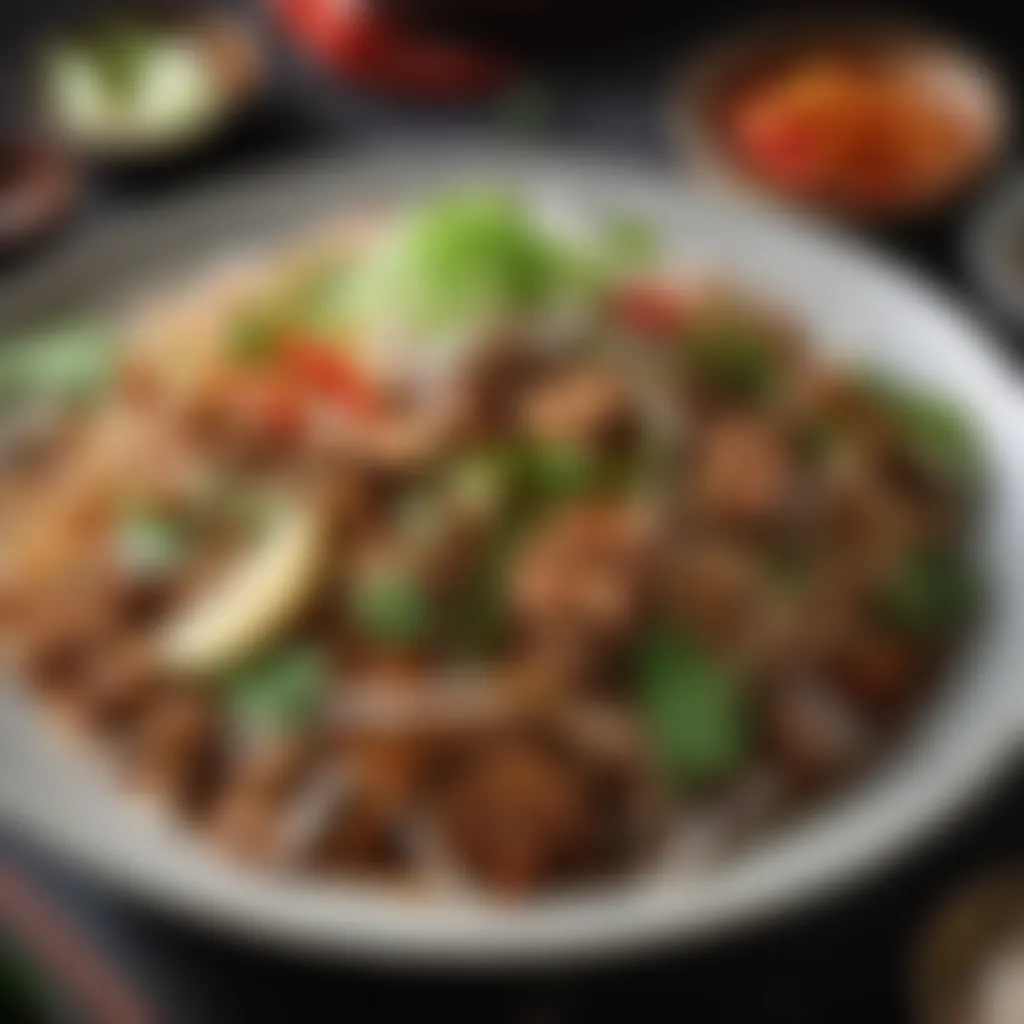
In contrast, Singaporean interpretation tends to be a touch sweeter, often incorporating sweet soy sauce and elements of chili for an extra kick. This regional diversity offers culinary enthusiasts a golden opportunity to explore and experiment.
Another notable variant is the Thai Kway Teow, where rice noodles are often served in a spicy soup, mixing seafood and vegetables that not only nourishes but also tantalizes taste buds.
"Noodles are incredibly versatile; every twist and turn in their preparation tells a story about the culture they come from."
Vegetarian Options
As more people turn to plant-based diets, vegetarian adaptations of Kway Teow have gained traction yet still remain true to the dish's characteristics. A vegetarian Kway Teow can be just as satisfying, utilizing a medley of vegetables like bok choy, carrots, and bell peppers. The key is to enhance flavors with ample aromatics.
To substitute for protein, consider tofu or tempeh that adds texture and richness to the dish. Marinating these ingredients in soy sauce and sesame oil can yield an umami-rich experience that even meat lovers can appreciate. Many local markets now provide vegetarian versions of traditional condiments, ensuring that flavor does not take a backseat.
Fusion Recipes
In today's culinary world, fusion cuisine is all the rage, and Kway Teow is no exception. Experimenting with different culinary techniques and ingredients from various cultures can lead to delicious and innovative dishes that still pay homage to the original. For instance, creating a Kway Teow stir-fry with Mediterranean ingredients like olives, artichokes, and feta cheese gives an interesting twist to the classic.
Or imagine combining the French notion of ratatouille with Kway Teow, tossing in zucchini, eggplants, and bell peppers in a savory sauce, producing a colorful and flavorful noodle dish. Fusion recipes not only broaden perspectives but encourage an exploration of culinary creativity.
By understanding these various adaptations of Kway Teow, you expand your cooking repertoire and appreciate the rich tapestry of cultural influences behind this beloved dish. Whether you stick to tradition or venture into fusion, there’s no wrong way to enjoy Kway Teow.
Cooking Tools and Equipment
When it comes to creating a delightful Kway Teow, having the right tools and equipment at your disposal is crucial. A well-equipped kitchen not only enhances your cooking experience but ensures that each component of the dish comes together seamlessly. Understanding the nuances of your cooking tools can make all the difference between a good meal and a mind-blowing one.
Essential Kitchen Utensils
The foundation of your cooking success lies in having the right kitchen utensils. Here are some staples you shouldn’t overlook:
- Wok: The star of the stir-frying process. Its round bottom allows heat circulation, making it perfect for quick cooking at high temperatures.
- Spatula: A sturdy spatula is essential for tossing and turning your ingredients without damaging them. Consider a wooden or silicone option to protect your wok.
- Measuring Cups and Spoons: Precision is key in balancing flavors, so keep these handy for measuring sauces and spices accurately.
- Knife and Cutting Board: Good knives are invaluable for chopping ingredients uniformly. A solid cutting board serves as your safe space for prep.
Choosing the Right Cookware
Selecting the proper cookware impacts your cooking results. For Kway Teow, you're not just looking for any old pan; consider these points:
- Material Matters: Opt for high-quality materials, such as cast iron or stainless steel. They distribute heat evenly, preventing hot spots that can scorch your noodles.
- Size: A large wok or frying pan will help accommodate multiple servings without overcrowding, allowing for that vital high-heat cooking.
- Non-stick Coating: Although traditionalists may shy away from non-stick, it can be helpful in preventing your Kway Teow from sticking, especially for novice cooks.
Techniques for Stir-Frying
Stir-frying is where the magic happens in preparing Kway Teow. Here are some techniques that can elevate your dish:
- Preheat Your Pan: Heat your wok on high until it’s almost smoking. This high temperature will help sear the ingredients quickly, retaining their textures.
- Work in Batches: Don’t add all your ingredients at once. This lowers the temperature and steams rather than fries. Fry proteins first, set them aside, then add veggies and finally noodles.
- Keep it Moving: Stir-frying needs constant movement. Use your spatula to toss and flip the ingredients, ensuring even cooking.
Effective stir-frying in a wok demands a blend of high-heat cooking and quick movements, which is essential to prevent burning while maintaining the crunch of vegetables and the texture of your noodles.
With the right tools and techniques in hand, you're all set to elevate your cooking. Equip yourself with these essentials, and your journey through the world of Kway Teow will be both enjoyable and rewarding.
Serving and Presentation
Serving Kway Teow well is more than just putting the dish on the table; it's an experience that can elevate a simple meal into something memorable. The way you present your food plays a significant role in how it's perceived and enjoyed. A dish that looks appealing can heighten anticipation and make even the most humble ingredients seem special. Moreover, Kway Teow, with its diverse textures and flavors, can benefit hugely from thoughtful serving techniques that allow each component to shine.
The importance of serving lies in creating an atmosphere of enjoyment. When set well, your dining space becomes inviting, which complements the experience of eating Kway Teow. Adding fresh elements like herbs or a splash of lime not only enhances visual appeal but also interacts with the palate, inviting diners to dive in with relish.
Accompaniments and Garnishes
Accompaniments are the unsung heroes of Kway Teow. A popular choice to accompany this savory dish is a side of crisp, pickled vegetables. These add a tangy crunch that cuts through the richness of the noodles and protein often included. You can also consider serving a small bowl of chili paste or sambal on the side, providing diners the chance to customize their spice level.
Here are some popular garnishes to enhance Kway Teow:
- Chopped scallions: Their fresh flavor brightens up the dish.
- Cilantro leaves: A pop of green can make the plate more visually appealing.
- Lime wedges: When squeezed over, they add a zesty kick.
- Prawn crackers: Serve on the side for a crunchy contrast.
Remember, a well-garnished dish not only looks good but also invites people to dig in.
Plating Techniques
Plating is an art form that can showcase Kway Teow beautifully. To make your dish look restaurant-worthy, take into account a few simple techniques. Start with a deep bowl or a flat plate based on your preference; each has its own charm. When using a bowl, stack the Kway Teow high, allowing the textures to show through, while with a plate, you can fan out the noodles elegantly for a horizontal display.
Another technique is to use the "layering" method. Place your protein on one side of the plate and the noodles on the other, creating a visual divide while also allowing diners to choose their bites. Drizzle a light soy sauce or oyster sauce on top, adding not only flavor but shine and contrast to the dish.
If you want to make it even more visually striking, consider utilizing:
- Color blocking: Use contrasting colors in your garnishes.
- Negative space: Leave some areas of the plate blank to give the food room to breathe.
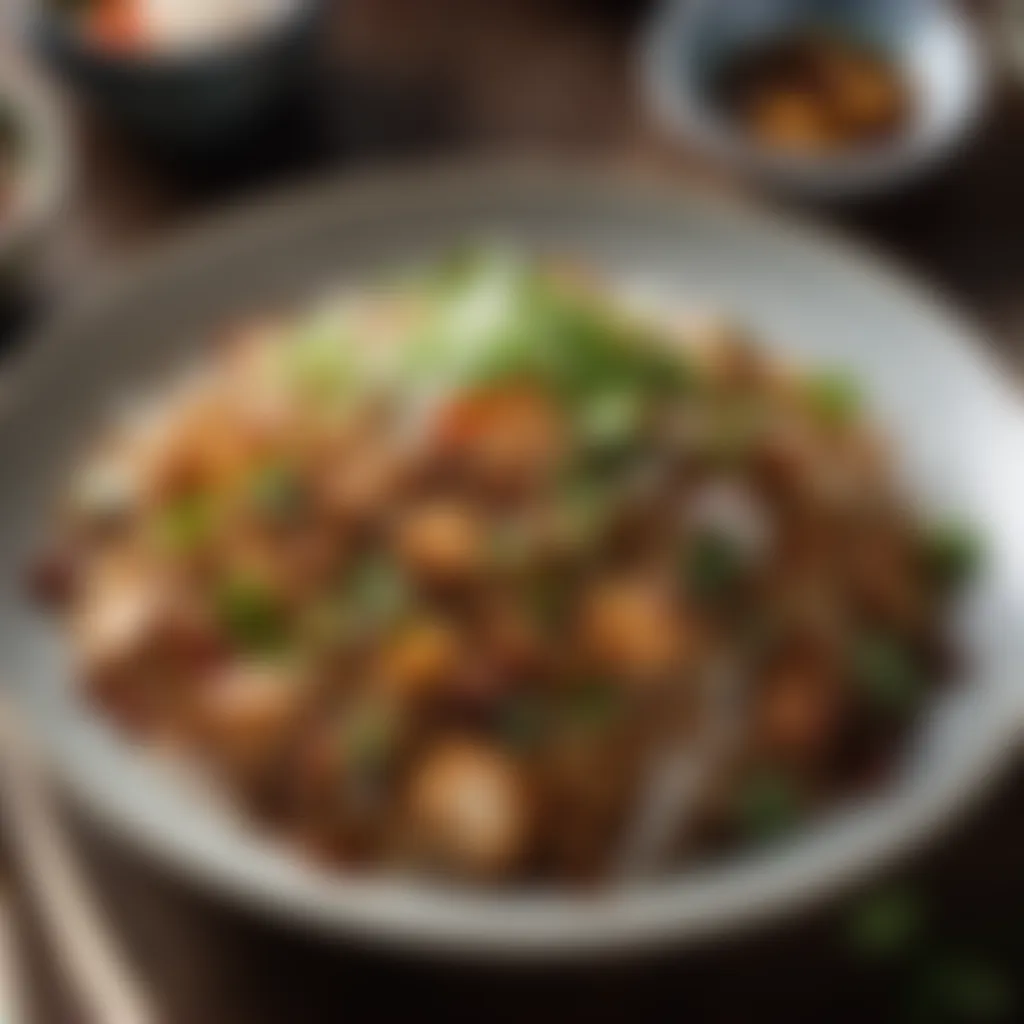
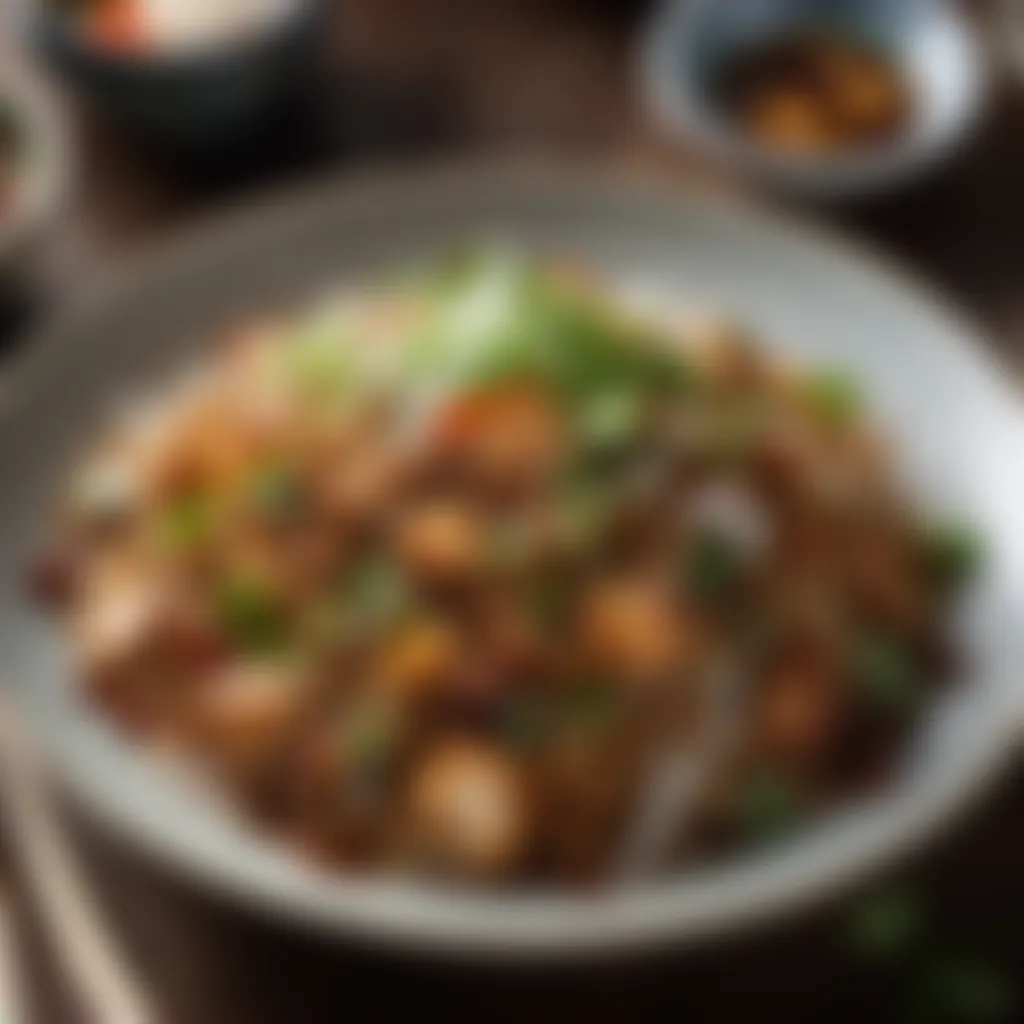
Ultimately, the chosen presentation style should highlight the beauty and texture of your Kway Teow, making it an experience that your loved ones will remember long after the last bite.
Kway Teow in Modern Cuisine
Kway Teow has gracefully woven itself into the fabric of modern culinary landscapes. Its versatility lends itself to various innovative interpretations while still preserving the essence of this beloved dish. Nowadays, chefs and home cooks alike are finding clever methods to incorporate Kway Teow, embracing not just traditional recipes but also exploring exciting contemporary angles.
This chapter not only honors Kway Teow's cultural roots but also examines how modern gastronomy breathes new life into this dish. The vibrant flavors and textures that characterize Kway Teow provide a robust canvas for creativity. It's a dish that tells a story, bridging culture with creativity, reaching everyday kitchens and high-end restaurants alike.
Gastronomic Innovations
In the bustling world of culinary arts, innovation reigns supreme. Kway Teow is thriving among these trends, evolving beyond its classic preparation. Modern chefs are rethinking flavors—infusing them with unconventional ingredients and techniques. For instance, some kitchens are opting for smoked proteins or creative sauces that play with traditional tastes. This is where the dish shines brightly.
Consider the incorporation of truffle oil or infused sesame oil to enhance the base flavors, or even the introduction of fresh, local vegetables. The beauty here lies in substitution; where once there was pork, quinoa could take its place for a healthier twist.
Additionally, imaginative plating has added a visual flair, turning each dish into a work of art. Chefs serve Kway Teow in manner that arouses curiosity and appetite, with ingredients artfully arranged, garnished with microgreens or edible flowers. It becomes not just a meal but a feast for the senses.
"Embracing innovation allows Kway Teow to transform from street food to a gourmet experience, inviting diners to savor every bite in a way they’ve never imagined."
Kway Teow in Fine Dining
The ascent of Kway Teow into fine dining establishments is a narrative of sophistication and respect for tradition. Top-tier restaurants have recognized this dish as more than mere comfort food; it’s used as a conduit to bridge East and West in culinary terms. Kway Teow's nuanced flavors are being explored and interpreted by chefs who know a good dish when they taste one.
An example of its evolution can feature Kway Teow elegantly paired with seafood—like scallops or lobster—allowing the subtle flavors of the seafood to dance in harmony with the noodles. These modern interpretations respect the original dish while elevating it to new heights. Dining experiences become captivating through tasting menus where Kway Teow features as an intricate part of a larger story.
Moreover, the focus on sustainability has permeated fine dining, leading chefs to source high-quality, local ingredients. But it's the storytelling behind Kway Teow that captivates many diners, creating a connection between patron and plate that goes beyond flavor. A dish once rooted in simplicity now tells a tale of innovation and cultural exchange.
As Kway Teow continues its journey through modern cuisine, it challenges perceptions and invites both chefs and food enthusiasts to relish in this age-old favorite with a contemporary twist, while still paying homage to its rich heritage.
Nutritional Aspects
Understanding the nutritional aspects of Kway Teow is vital, especially for those who cherish both flavor and well-being. Recognizing what goes into this dish can help cooks fortify it, ensuring they achieve a balanced meal that delights the senses as much as it serves body health.
Analyzing Ingredients
Each component in Kway Teow contributes to its unique nutritional profile. The base, flat rice noodles, are primarily made up of carbohydrates, providing a source of energy that fuels our daily activities. However, they lack significant amounts of protein and essential vitamins. This is where additional ingredients come into play.
- Proteins: Adding proteins like chicken, shrimp, or tofu can significantly enhance the dish's overall nutrition. Each of these options contributes to muscle repair and growth, which is crucial for an active lifestyle.
- Vegetables: A mix of veggies like bean sprouts, bok choy, or carrots not only introduces color and texture but also brings fiber, vitamins, and antioxidants into the dish. This addition aids digestion and boosts the immune system, making the dish more wholesome.
- Sauces and Seasonings: While sauces like soy sauce or oyster sauce add depth of flavor, they also come with sodium. Monitoring this element is essential, as excessive salt can lead to health conditions. Choosing low-sodium varieties can help maintain taste without sacrificing health.
"Food is not only nutrition; it’s a love affair with flavors. But don’t forget that choices matter for both taste and health!"
Dietary Considerations
When preparing Kway Teow, considering the dietary needs of your family or guests is paramount. Different diets mean different considerations:
- Gluten-Free Options: Traditional Kway Teow uses rice noodles, which are gluten-free. However, cross-contamination can be tricky. Ensure that all cooking equipment and ingredients are gluten-free if needed.
- Vegetarian and Vegan: Those avoiding animal products can easily adapt Kway Teow by using plant-based proteins such as tempeh or seitan and incorporating a plethora of vegetables. This adjustment not only caters to preferences but broadens the nutritional base of the meal.
- Caloric Awareness: While Kway Teow can be a relatively low-calorie dish, it’s essential to monitor portion sizes, especially with abundant sauces and proteins. Keeping an eye on portions helps maintain a balanced diet without feeling deprived.
- Managing Allergies: Always consider food allergies, especially regarding shellfish. Being upfront about what’s included or substituting where necessary ensures everyone can enjoy this delightful dish without worry.
In summary, the nutritional aspects of Kway Teow provide a window not only into its ingredients but also into healthier cooking practices that consider the diverse needs of eaters today.
The End
The conclusion serves as the culmination of everything explored about Kway Teow throughout the article. Reflecting on this journey not only highlights its origins but also underscores its profound cultural significance. Kway Teow, in its various forms, is a testament to the rich culinary tapestry of Asia. It's not merely a dish but a vibrant narrative woven from traditions, family connections, and innovations.
With each plate of Kway Teow, there’s an invitation to engage with history and flavors that have meandered through different regions. For those new to cooking, the conclusion offers encouragement to experiment with flavors and make the dish their own. It illuminates the essence of cooking, which blends learning and creativity, allowing individuals to craft something heartfelt.
In addition, the wrapping up of this culinary adventure signals future possibilities. Kway Teow is adaptable, evolving with contemporary trends while retaining its roots. Understanding its journey can inspire cooks to embrace culinary innovations, crafting personalized variations that reflect their own tastes and experiences.
"Every dish tells a story. Kway Teow is a chapter filled with flavor, tradition, and creativity.”
In essence, the conclusion encourages readers to not just see Kway Teow as a recipe, but as a doorway to exploring more about Asian culinary heritage and their own culinary skills.
Reflecting on Kway Teow’s Journey
Kway Teow’s history is rich with layers of adaptation and resilience. From its humble beginnings in the streets of Southeast Asia to its status in modern fine dining, the journey of this dish is a reflection of the changing culinary landscape. Originating possibly from Chinese immigrants, Kway Teow has crossed oceans and cultures, picking up flavors and techniques along the way.
Each regional variation of Kway Teow tells a different story. For instance, Penang Char Kway Teow is known for its smoky char, while the Kuala Lumpur version often emphasizes a richer sauce. This fascinating evolution encapsulates how food can act as a bridge between cultures, reflecting the tastes, ingredients, and traditions of each place it touches.
Kway Teow serves as a delicious reminder that food is more than just sustenance. It holds memories, fosters relationships, and creates connections that transcend language and geography. It’s a celebration of shareholding vast flavors and different culinary practices that come together in a harmonious dish.
The Future of Kway Teow
The future of Kway Teow shines brightly as culinary trends shift towards healthier eating and sustainability. Chefs are reimaging traditional practices, introducing whole grain noodles or using plant-based proteins to cater to an increasingly health-conscious audience. This adaptability assures Kway Teow remains relevant in a fast-evolving food landscape.
Moreover, as global travel continues to merge cultural experiences, fusion recipes bloom. Imagine Kway Teow infused with Italian herbs or served with a southwestern twist—a dish that evokes the spirit of culinary innovation while staying true to its roots.
In terms of culinary education, Kway Teow’s approachable nature makes it an excellent dish for aspiring cooks. By understanding its basic technique, they can explore limitless possibilities, turning each meal preparation into an opportunity for creativity.
To put it succinctly, Kway Teow is an emblem of culinary resilience and innovation. Its future promises a blend of tradition and modernity that will keep food lovers intrigued and delighted.







